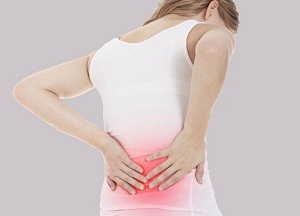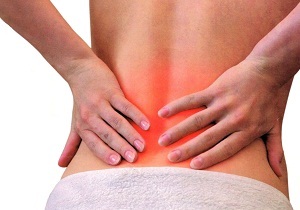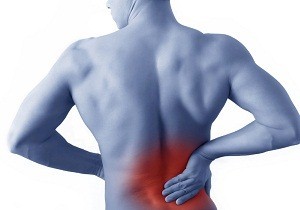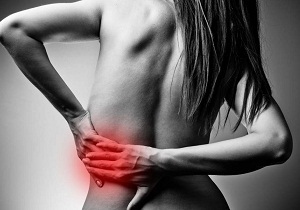
Back problems are very common. According to statistics, more than 30% of the population face pain. About 80% of them suffer from pain of varying intensity throughout their adult lives.
Pain in the lumbar region occurs more often than in other segments of the spine. This is due to the fact that the lower back has the greatest load, the risk of developing pathological processes in this area is higher. Pain in the lumbar region can be associated not only with diseases of the spine, but also with pathologies of internal organs. Before treating low back pain, it is important to discover the nature of its origin.
Causes of pain syndrome
90% of low back pain is associated with vertebral pathology, congenital and acquired.
The most common causes are:
- osteochondrosis of the lumbosacral region;
- intervertebral extensions and hernias;
- spondylosis;
- spondyloarthritis.
Congenital anomalies that cause pain:
- irregular shape of vertebral processes;
- bead separation;
- congenital curvature of the spine.
Neurological causes of low back pain:
- suppression of nerve roots;
- lumboischialgia (occurs when the sciatic nerve is damaged);
- multiple sclerosis.
Low back pain can be reflective and symptomatic of non-spinal diseases:
- urinary tract and genital infections;
- kidney disease;
- nephrolithiasis and urolithiasis (kidney and bladder stones);
- tumor formations in the gastrointestinal tract;
- hemorrhoids;
- uterine neoplasms in women;
- radiculitis;
- as a complication after previous viral infections.

Sometimes severe back pain in the lumbar region occurs against the background of physiological changes:
- during menstruation;
- after birth;
- during pregnancy;
- as a result of rapid weight gain.
Provocative factors for low back pain can be:
- hypothermia;
- weakening of the immune system and body against the background of infectious lesions;
- irregular physical activity;
- work related to a long stay in a sitting position (office workers, drivers);
- excessive stress, which causes compression fractures of the spine, cracks, stretching of the back muscles;
- power sports (bodybuilding, bodybuilding, shot shot);
- Inadequate nutrition - lack of vitamins and elements necessary for bone tissue (phosphorus, calcium, fluoride), excessive consumption of high-calorie foods;
- curvature of the spine (flexion, kyphosis, scoliosis);
- stressful situations - prolonged nervous tension exacerbates a number of chronic diseases, weakens the body.
Determining the nature of pain
Back pain in the lumbar spine can be of different nature:
- acute pain (lasting up to a month and a half);
- subacute (one and a half to three months);
- chronic (more than three months).
Types of pain:
- Nonspecific - there is no clear localization of pain sensations and the reasons for their appearance.
- Specific - is a symptom of certain diseases (tumors, hernias, osteoporosis).

Acute low back pain, usually sudden, occurs as a lumbar "lumbago" (lumbago). The pain can radiate to the buttocks, lower extremities and other parts of the body, mimicking certain diseases.
Depending on what caused the low back pain, they may be of a different nature (stabbing, cutting, crushing, fracturing, pain).
At the beginning of the development of the pathological process, the pain is often not pronounced. The patient may experience discomfort in the affected area, a feeling of “goose bumps” on the skin. Gradually, the symptoms begin to increase and become more pronounced.
Pay attention!It is very important not to delay visiting a specialist. If not treated in time, the pain will become stronger, in the future there may be signs of disruption of the work of other organs and systems (sexual dysfunction, urinary incontinence, paresis, limitation of motor activity).
Effective treatments
Before starting treatment for low back pain, you should see a vertebrologist or neurologist. He will try to find out the cause of the pain, describe the necessary research. If necessary, he will send for consultation with other specialists (gastroenterologist, gynecologist, urologist).
In addition to patient interview and visual examination, it is recommended that you diagnose using instrumental methods:
- radiography;
- CT;
- MRI;
- electromyelography.
Furthermore, a general blood and urine test, sampling of material for histological examination may be required.
The following conditions require immediate medical attention:
- for the first time and the sudden onset of low back pain;
- radiation of pain in the lower leg and foot, a combination of pain with numbness of the thigh, foot;
- history of trauma;
- urinary and fecal incontinence;
- duration of pain for more than 3 days;
- presence of oncological disease;
- loss of appetite and dramatic weight loss;
- chills and fever;
- presence of bacterial infections;
- inability to self-service due to pain.
In most cases, low back pain occurs due to damage to the vertebral structures, it is necessary to eliminate its cause. The treatment approach should be comprehensive.
Medications
For any back pain, medications are used first to relieve it. The doctor prescribes several groups of medicines in the form of injections, tablets, oils.
Without discovering the cause of the pain, prescribing certain medications (for example, NSAIDs or analgesics) can only make the situation worse.
For spinal diseases, the use of NSAIDs and analgesics for pain relief, inflammation relief is recommended.
Muscle spasms are relieved by intramuscular or oral administration of short-term muscle relaxants (up to 5 days).
Using oils for back pain is effective as an adjunct treatment for back problems. They help to reduce pain, relieve inflammation and have a warming effect. Ointments are anti-inflammatory, analgesic, combined, irritating, chondroprotective. External remedies should be prescribed by a physician, based on the therapeutic effect to be achieved.
Corticosteroid injections are sometimes used to quickly relieve severe pain. The drugs are injected directly into the lesions. The course of such treatment should not exceed 2-3 injections.
Drug therapy
To restore the lower back and strengthen the outcome of drug therapy, it is recommended to use the following measures:
- massage;
- manual therapy;
- exercise therapy;
- reflexology;
- yoga;
- physiotherapy and other methods of influence.
These methods improve blood supply to problem areas, strengthen muscle tissue and ligaments, make them more elastic, and reduce pain. Every medical procedure cannot be performed independently, without the supervision of a specialist. A certain way of loading must be observed.
Helpful Tips
Tips:

- In case of back pain, physical activity should be significantly reduced and it is better to ensure peace during the first 2 days of an attack.
- Prolonged bed rest is not recommended unless there are fractures, high fever or other aggravating symptoms. Moderate activity always benefits the spine.
- Taking painkillers is best in case of unbearable pain. Better yet to protect the gastrointestinal tract as much as possible from the effects of medication.
- Better it is better to sleep in the fetal position, to lighten the load on the lower back, you can place a pillow between your legs.
- In case of problems with the lower back, it is advisable to walk as often as possible, to do a warm-up at work, which requires prolonged lowering.
Prevention of low back pain
Pain is a symptom of a malfunction in the body. To avoid problems with the lower back, it is necessary to prevent the appearance of provocative factors as much as possible.
Preventive measures include:
- Moderate regular exercise. Physical education should be given at least half an hour a day. Useful useful to do yoga, swimming, morning exercise.
- Compliance with drinking regime. You should drink up to 2 liters of juice a day. Most should be in the first half of the day. After 8 pm it is better not to drink any juice at all.
- Eat well. Significantly reduce your intake of fatty, high-calorie foods. Better to use boiled and steamed dishes.
- At least once a year, a routine check-up should be done.
- 2 times a year to undergo a therapeutic massage course.
Low back pain is a signal that there is a problem in the body. The causes of pain can be numerous. You can not stop it immediately with pain pills, you should seek help from a specialist and be examined. Above all, the problem can be hidden not only in the spine, but in the disruption of the work of other organs and systems. The sooner the cause of the pain is identified and treated, the higher the chance of cure.



































